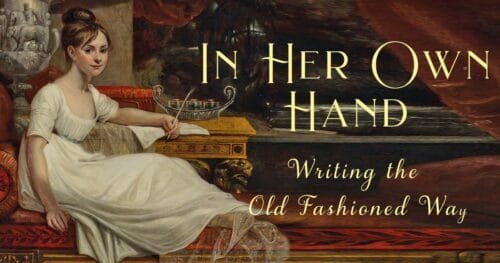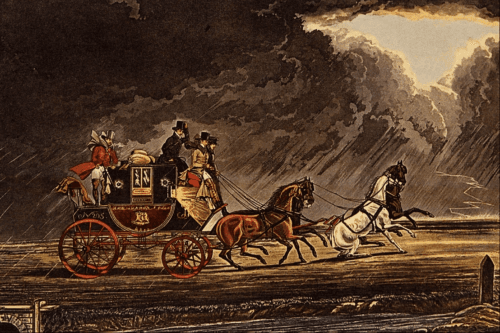How a Letter got from Here to There

Once a letter was written, getting the letter into the recipient could be a challenge. Since stamps did not exist until 1840, letters had to be hand stamped with ink, which would declare a letter’s postage paid or unpaid and the amount due upon receipt. This required a trip to the post office. If that post office was in a village or town that was not a postal stop, the letter would be sent to a post town first. At that point, the Royal Mail would take over.
For decades the system was slow, expensive and unreliable. During the Regency era, the postal system experienced dramatic changes.
Post Office Reforms
The public postal service was first introduced in England around 1635 during the reign of Charles I. For the next 150 years, letters would be carried between ‘posts’ and delivered to local postmasters, by post-boys on horseback. The postmasters would sort the letters destined for their area and send the rest along to the next post station via another post-boy.

Not surprisingly the system was slow and dangerous, with post-boys not infrequently being the target of robbers and highwaymen.
Reform came in 1782 through John Palmer, a theater owner who had devised a carriage service to transport actors and props rapidly from one theater to the next. If it worked for the theater, why not the postal service? Despite resistance from the post staff, Willim Pitt, Chancellor of the Exchequer took a risk on the idea. The first mail coach (paid for out of Palmer’s own pocket) departed Bristol on August 2, 1784 and reached London sixteen hours later. Typically, that journey took thirty-eight hours.
Over the next several years, the routes grew to service with to London, Norwich, Liverpool, Leeds, Dover, Portsmouth, Poole, Exeter, Gloucester, Worcester, Holyhead, Carlisle, and Edinburgh. In 1786, Palmer became Surveyor and Comptroller General of the Post Office.
By 1811, more than two hundred mail coaches ran regular deliveries on “post roads”. However, private individuals were still contracted to serve as postmasters and to make deliveries between post towns, and to provide horses and coachmen, and sometimes coaches for the post.
Mail Coach

Specialized mail coaches made up the backbone of the service. In 1887, a newly improved, patented coach design by John Besant was adopted for post office use. These vehicles traveled between the post town at average speeds of 7-8 mph. Travel was slower in the winter, but as roads improved, speed increased to 10 pm by the Victorian Era. Compared to the 3-4 mph managed by the post boys, the improvement was dramatic.
The only post office employee on the coach was the armed, uniformed guard. Carrying two pistols and a blunderbuss, he recorded the arrival and departure times at each stage of the journey and also sounded a horn to warn others on the road to make way and for tollkeepers to let the coach through.
The coach did not stop in every town or village it passed there. Instead, the guard would throw out a bag of mail to the Letter Receiver or Postmaster and grab bags of outgoing mail from the same.

In addition to the mail, mail coaches carried passengers, hence the term to travel by post. While fast and less expensive, traveling by mail coach was often uncomfortable. It only stopped for postal business, rather than for meals or other conveniences. If the road got rough or steep, passengers might be required to get off and walk to spare the horses.
In the country, once letters reached the post office, there was often no standardized method for delivery. So, individuals would have to call at the local post office, which might be housed with another business, like an inn, to collect their letters. Postmasters were permitted to charge a fee to deliver mail to non-post office villages and estates.
Eventually the railway replaced the mail coaches, with the last coached based route ending in 1846.
Postage
Postage in the early years of the Royal Mail was prohibitively expensive. The postage charged depending on the number of sheets written and the distance they traveled. Postage was paid by the recipient and could be over a day’s wage, sometimes much more. Many letters went undelivered because the postage was out of reach. (Side note here, the original reason the recipient would pay for the mail was to improve the chances the post boys would actually deliver it since their wages came from what they collected.)
During the Regency era, postal rates were set of a single sheet letter, with a second sheet doubling the cost. If the letter weighed an ounce the postages was raised to quadruple a singe sheet.
Letters from the Past provides this sample of postage rates.
| Distance during 1805-1812 | Cost in pence | Notes |
| Not exceeding 15 miles | 4 | a ‘one-horse stage’ |
| 15 to 30 miles | 5 | Leith/Haddington |
| 30 to 50 miles | 6 | Tetsworth |
| 50 to 80 miles | 7 | Dover |
| 80 to 120 miles | 8 | Birmingham |
| 120 to 170 miles | 9 | Derby |
| 170 to 230 miles | 10 | Cardiff/Aberdare |
| 230 to 300 miles | 11 | Newcastle-on-Tyne |
| for every 100 miles above 300 | add 2d | Southwell |
Penny post

The Penny Post, began as a private enterprise around 1680, later taken over by the Post Office in 1683. (The founder William Dockwra was forced to pay damages for taking business from the official mail service.) The Penny Post offered delivery of letters (anything weighing up to a pound) within the city of London for a penny. The postage was prepaid by the sender rather than the receiver. Several hundred receiving offices collected the letters and sent them to six sorting facilities. From there multiple deliveries were made within the city. For an extra penny, deliveries would be made up to ten miles outside of London.
The Penny Post was so popular that it spread to other cities and towns. Its popularity made it a target for raising government revenue, though. To help fund the Napoleonic wars, the price doubled to two pence in 1801 and three in 1805.
Express Letters
Jane Austen mentions sending an express message in Pride and Prejudice. In this case an individual carried the message directly to the recipient. It could be contracted through the regular post office or with a private individual. Through the post office, the rider could change horses at the posting houses along his route as well as pass through toll booths freely. A private courier would not benefit from those privileges. The service could be very expensive, costing as much as several pounds. (Pratt, 1799)
References
Hemmeon, J. C., PhD. The History of The British Post Office. Harvard Economics Studies, Published under the direction of the Department of Economics Vol VII, From the Income of the William H. Baldwin, Jr., 1885, Fund, Cambridge Harvard University. 1912 https://gutenberg.org/files/42983/42983-h/42983-h.htm
Shanahan, Eunice. Postage Rages within Great Britain 1805-1839. Letters from the Past. Accessed June 9, 2023. http://www.earsathome.com/letters/Previctorian/rates.html
Ivies, Susanna. Lost int the Regency Mail. My Floating World Blog. March 2012. Accessed February 14, 2024. https://susannaives.com/wordpress/2012/03/lost-in-the-regency-mail/
Donnelly, Shannon. The Regency Post A Pity We’ve Lost Letters. Shannon Donnelly.com May, 29, 2010. Accessed February 20, 20204. https://shannondonnelly.com/2010/05/29/the-regency-post-a-pity-weve-lost-letters/
Sanford, Vic. The Postal Service in 18th Century Britain: Post Roads and Post-Boys. Jane Austen’s World. September 12, 2009Accessed May 1, 2024. https://janeaustensworld.com/2009/09/12/the-postal-service-in-18th-century-britain-post-roads-and-post-boys/
Mail Coaches. The Postal Museum. Postal Heritage Trust. Accessed February 10, 2024. https://www.postalmuseum.org/collections/mail-coaches/
Sanford, Vic. The Postal Service in 18th Century Britain: Letters and the Penny-Post. Jane Austen’s World. September 9, 2009. Accessed May 1, 2024. https://janeaustensworld.com/2009/09/09/the-postal-service-in-18th-century-britain-letters-and-the-penny-post/
Pratt, Samuel Jackson. Gleanings In England: Descriptive Of The Countenance, Mind, And Character Of The Country, Volume 1. 1799.

Now we don’t do as much letter writing. We email instead!
I love writing letters. It is a good thing as my friend doesn’t send emails nor does she text. We are old school like that. And… I heard that postage is going up again.
Really interesting post! You say the post-boys just carried mail between the ‘posts’ and it was the post-masters that delivered the mail to people’s houses… but then later you say that the post-boys got paid on delivery of the letters. So who was it that actually delivered to the houses – the postmasters or post-boys? And was there a different arrangement for the big country houses? Thanks.
Mail was carried between posts by post boys to the post masters. The post masters were then responsible for distributing it to the houses. They might do it themselves in small villages or might have post boys to do the deliveries in larger areas. Post might be delivered several times a day. I am not familiar with any differences for big country houses.